Analysis of Temperature Semi-Annual Oscillations (SAO) in the Middle Atmosphere
Abstract
:1. Introduction
2. Data and Methods
2.1. MLS Data
2.2. Reanalysis Data
2.3. WACCM
2.4. Thermal Energy Budget
2.5. Time Series Analysis
3. Results and Discussion
3.1. Spatial Analysis of the SAO
3.2. Time Analysis of the SAO
3.3. Mechanism of the SAO
3.4. Relationship between the SAO and SSTs
4. Conclusions
Author Contributions
Funding
Data Availability Statement
Acknowledgments
Conflicts of Interest
References
- Labitzke, K.; Barnett, J.J. Global time and space changes of satellite radiances received from the stratosphere and lower mesosphere. J. Geophys. Res. 1973, 78, 483–496. [Google Scholar] [CrossRef]
- Chandra, S.; Fleming, E.L.; Schoeberl, M.R.; Barnett, J.J. Monthly mean global climatology of temperature, wind, geopotential height and pressure for 0–120 km. Adv. Space Res. 1990, 10, 3–12. [Google Scholar] [CrossRef]
- Ern, M.; Diallo, M.; Preusse, P.; Mlynczak, M.G.; Schwartz, M.J.; Wu, Q.; Riese, M. The semiannual oscillation (SAO) in the tropical middle atmosphere and its gravity wave driving in reanalyses and satellite observations. Atmos. Chem. Phys. 2021, 21, 13763–13795. [Google Scholar] [CrossRef]
- REED, R.J. Some Features of the annual temperature regime in the tropical stratosphere. Mon. Weather Rev. 1962, 90, 211–215. [Google Scholar] [CrossRef]
- Reed, R.J. Zonal wind behavior in the equatorial stratosphere and lower mesosphere. J. Geophys. Res. 1966, 71, 4223–4233. [Google Scholar] [CrossRef]
- Volland, H. A theory of thermospheric dynamics—II: Geomagnetic activity effect, 27-day variation and semiannual variation. Planet. Space Sci. 1969, 17, 1709–1724. [Google Scholar] [CrossRef]
- van Loon, H.; Labitzke, K.; Jenne, R.L. Half-yearly wave in the stratosphere. J. Geophys. Res. 1972, 77, 3846–3855. [Google Scholar] [CrossRef]
- Hirota, I. Observational evidence of the semiannual oscillation in the tropical middle atmosphere—A review. Pure Appl. Geophys. 1980, 118, 217–238. [Google Scholar] [CrossRef]
- Zhang, Y.; Sheng, Z.; Shi, H.; Zhou, S.; Shi, W.; Du, H.; Fan, Z. Properties of the Long-Term Oscillations in the Middle Atmosphere Based on Observations from TIMED/SABER Instrument and FPI over Kelan. Atmosphere 2017, 8, 7. [Google Scholar] [CrossRef]
- Gao, X.H.; Yu, W.B.; Stanford, J.L. Global Features of the Semiannual Oscillation in Stratospheric Temperatures and Comparison between Seasons and Hemispheres. J. Atmos. Sci. 1987, 44, 1041–1048. [Google Scholar] [CrossRef]
- Young, P.J.; Thompson, D.W.J.; Rosenlof, K.H.; Solomon, S.; Lamarque, J.F. The Seasonal Cycle and Interannual Variability in Stratospheric Temperatures and Links to the Brewer–Dobson Circulation: An Analysis of MSU and SSU Data. J. Clim. 2011, 24, 6243–6258. [Google Scholar] [CrossRef]
- Ganguly, S. Semiannual variations in the mesosphere. J. Geophys. Res. 1975, 80, 3722–3724. [Google Scholar] [CrossRef]
- Hamilton, K. Rocketsonde observations of the mesospheric semiannual oscillation at Kwajalein. Atmos.-Ocean 1982, 20, 281–286. [Google Scholar] [CrossRef]
- Dunkerton, T.J. Theory of the Mesopause Semiannual Oscillation. J. Atmos. Sci. 1982, 39, 2681–2690. [Google Scholar] [CrossRef]
- Sassi, F.; Garcia, R.R. The Role of Equatorial Waves Forced by Convection in the Tropical Semiannual Oscillation. J. Atmos. Sci. 1997, 54, 1925–1942. [Google Scholar] [CrossRef]
- Richter, J.H.; Garcia, R.R. On the forcing of the Mesospheric Semi-Annual Oscillation in the Whole Atmosphere Community Climate Model. Geophys. Res. Lett. 2006, 33, L01806. [Google Scholar] [CrossRef]
- Lossow, S.; Urban, J.; Gumbel, J.; Eriksson, P.; Murtagh, D. Observations of the mesospheric semi-annual oscillation (MSAO) in water vapour by Odin/SMR. Atmos. Chem. Phys. 2008, 8, 6527–6540. [Google Scholar] [CrossRef]
- Mayr, H.; Mengel, J.; Chan, K.; Huang, F. Middle atmosphere dynamics with gravity wave interactions in the numerical spectral model: Zonal-mean variations. J. Atmos. Sol.-Terr. Phys. 2010, 72, 807–828. [Google Scholar] [CrossRef]
- Smith, A.K.; Holt, L.A.; Garcia, R.R.; Anstey, J.A.; Serva, F.; Butchart, N.; Osprey, S.; Bushell, A.C.; Kawatani, Y.; Kim, Y.H.; et al. The equatorial stratospheric semiannual oscillation and time-mean winds in QBOi models. Q. J. R. Meteorol. Soc. 2020, 148, 1593–1609. [Google Scholar] [CrossRef]
- Huang, F.T.; Mayr, H.G.; Reber, C.A.; Russell, J.M.; Mlynczak, M.; Mengel, J.G. Stratospheric and mesospheric temperature variations for the quasi-biennial and semiannual (QBO and SAO) oscillations based on measurements from SABER (TIMED) and MLS (UARS). Ann. Geophys. 2006, 24, 2131–2149. [Google Scholar] [CrossRef] [Green Version]
- Smith, A.K.; Garcia, R.R.; Moss, A.C.; Mitchell, N.J. The Semiannual Oscillation of the Tropical Zonal Wind in the Middle Atmosphere Derived from Satellite Geopotential Height Retrievals. J. Atmos. Sci. 2017, 74, 2413–2425. [Google Scholar] [CrossRef]
- Zhao, X.R.; Sheng, Z.; Shi, H.Q.; Weng, L.B.; He, Y. Middle Atmosphere Temperature Changes Derived from SABER Observations during 2002–20. J. Clim. 2021, 34, 7995–8012. [Google Scholar] [CrossRef]
- Long, C.S.; Fujiwara, M.; Davis, S.; Mitchell, D.M.; Wright, C.J. Climatology and interannual variability of dynamic variables in multiple reanalyses evaluated by the SPARC Reanalysis Intercomparison Project (S-RIP). Atmos. Chem. Phys. 2017, 17, 14593–14629. [Google Scholar] [CrossRef]
- Shangguan, M.; Wang, W. The semi-annual oscillation (SAO) in the upper troposphere and lower stratosphere (UTLS). Atmos. Chem. Phys. 2022, 22, 9499–9511. [Google Scholar] [CrossRef]
- Thompson, D.W.J.; Baldwin, M.P.; Wallace, J.M. Stratospheric Connection to Northern Hemisphere Wintertime Weather: Implications for Prediction. J. Clim. 2002, 15, 1421–1428. [Google Scholar] [CrossRef]
- Charlton-Perez, A.J.; Baldwin, M.P.; Birner, T.; Black, R.X.; Butler, A.H.; Calvo, N.; Davis, N.A.; Gerber, E.P.; Gillett, N.; Hardiman, S.; et al. On the lack of stratospheric dynamical variability in low-top versions of the CMIP5 models. J. Geophys. Res. Atmos. 2013, 118, 2494–2505. [Google Scholar] [CrossRef]
- Gettelman, A.; Mills, M.J.; Kinnison, D.E.; Garcia, R.R.; Smith, A.K.; Marsh, D.R.; Tilmes, S.; Vitt, F.; Bardeen, C.G.; McInerny, J.; et al. The Whole Atmosphere Community Climate Model Version 6 (WACCM6). J. Geophys. Res. Atmos. 2019, 124, 12380–12403. [Google Scholar] [CrossRef]
- Marsh, D.R.; Mills, M.J.; Kinnison, D.E.; Lamarque, J.F.; Calvo, N.; Polvani, L.M. Climate Change from 1850 to 2005 Simulated in CESM1(WACCM). J. Clim. 2013, 26, 7372–7391. [Google Scholar] [CrossRef]
- Schoeberl, M.; Douglass, A.; Hilsenrath, E.; Bhartia, P.; Beer, R.; Waters, J.; Gunson, M.; Froidevaux, L.; Gille, J.; Barnett, J.; et al. Overview of the EOS aura mission. IEEE Trans. Geosci. Remote Sens. 2006, 44, 1066–1074. [Google Scholar] [CrossRef]
- Waters, J.; Froidevaux, L.; Harwood, R.; Jarnot, R.; Pickett, H.; Read, W.; Siegel, P.; Cofield, R.; Filipiak, M.; Flower, D.; et al. The Earth observing system microwave limb sounder (EOS MLS) on the aura Satellite. IEEE Trans. Geosci. Remote Sens. 2006, 44, 1075–1092. [Google Scholar] [CrossRef]
- Livesey, N.J.; Read, W.G.; Froidevaux, L.; Lambert, A.; Santee, M.L.; Schwartz, M.J.; Millán, L.F.; Jarnot, R.F.; Wagner, P.A.; Hurst, D.F.; et al. Investigation and amelioration of long-term instrumental drifts in water vapor and nitrous oxide measurements from the Aura Microwave Limb Sounder (MLS) and their implications for studies of variability and trends. Atmos. Chem. Phys. 2021, 21, 15409–15430. [Google Scholar] [CrossRef]
- Schwartz, M.J.; Lambert, A.; Manney, G.L.; Read, W.G.; Livesey, N.J.; Froidevaux, L.; Ao, C.O.; Bernath, P.F.; Boone, C.D.; Cofield, R.E.; et al. Validation of the Aura Microwave Limb Sounder temperature and geopotential height measurements. J. Geophys. Res. Atmos. 2008, 113, D15S11. [Google Scholar] [CrossRef]
- Lee, J.N.; Wu, D.L. Solar Cycle Modulation of Nighttime Ozone Near the Mesopause as Observed by MLS. Earth Space Sci. 2020, 7, e2019EA001063. [Google Scholar] [CrossRef]
- Livesey, N.; Coauthors. Earth Observing System (EOS) Aura Microwave Limb Sounder (MLS) Version 5.0x Level 2 and 3 data quality and description document. JPL Tech. Rep. 2022, JPL D-105336 Rev. B, 168–171. [Google Scholar]
- Hersbach, H.; Bell, B.; Berrisford, P.; Hirahara, S.; Horányi, A.; Muñoz-Sabater, J.; Nicolas, J.; Peubey, C.; Radu, R.; Schepers, D.; et al. The ERA5 global reanalysis. Q. J. R. Meteorol. Soc. 2020, 146, 1999–2049. [Google Scholar] [CrossRef]
- Gelaro, R.; McCarty, W.; Suárez, M.J.; Todling, R.; Molod, A.; Takacs, L.; Randles, C.A.; Darmenov, A.; Bosilovich, M.G.; Reichle, R.; et al. The Modern-Era Retrospective Analysis for Research and Applications, Version 2 (MERRA-2). J. Clim. 2017, 30, 5419–5454. [Google Scholar] [CrossRef]
- Hersbach, H.; Bell, B.; Berrisford, P.; Biavati, G.; Horányi, A.; Muñoz Sabater, J.; Nicolas, J.; Peubey, C.; Radu, R.; Rozum, I.; et al. ERA5 monthly averaged data on pressure levels from 1979 to present. Copernicus Climate Change Service (C3S) Climate Data Store (CDS). 2019. Available online: https://cds.climate.copernicus.eu/cdsapp#!/dataset/10.24381/cds.6860a573?tab=overview (accessed on 18 July 2022).
- GMAO. Global Modeling and Assimilation Office, instM_3d_asm_Np: MERRA2 3D IAU State, Meteorology Monthly Mean, Version 5.12.4, Greenbelt, MD, USA: Goddard Space Flight Center Distributed Active Archive Center (GSFC DAAC) 2015. Available online: https://disc.gsfc.nasa.gov/datasets/M2IMNPASM_5.12.4/summary (accessed on 18 July 2022).
- GMAO. Global Modeling and Assimilation Office, tavgM_3d_tdt_Np: MERRA2 3D IAU State, Meteorology Monthly Mean, Version 5.12.4, Greenbelt, MD, USA: Goddard Space Flight Center Distributed Active Archive Center (GSFC DAAC) 2015. Available online: https://disc.gsfc.nasa.gov/datasets/M2TMNPTDT_5.12.4/summary (accessed on 18 July 2022).
- Fujiwara, M.; Wright, J.S.; Manney, G.L.; Gray, L.J.; Anstey, J.; Birner, T.; Davis, S.; Gerber, E.P.; Harvey, V.L.; Hegglin, M.I.; et al. Introduction to the SPARC Reanalysis Intercomparison Project (S-RIP) and overview of the reanalysis systems. Atmos. Chem. Phys. 2017, 17, 1417–1452. [Google Scholar] [CrossRef]
- Rayner, N.A.; Parker, D.E.; Horton, E.B.; Folland, C.K.; Alexander, L.V.; Rowell, D.P.; Kent, E.C.; Kaplan, A. Global analyses of sea surface temperature, sea ice and night marine air temperature since the late nineteenth century. J. Geophys. Res. Atmos. 2003, 108, 4407. [Google Scholar] [CrossRef]
- Matthes, K.; Funke, B.; Andersson, M.E.; Barnard, L.; Beer, J.; Charbonneau, P.; Clilverd, M.A.; Dudok de Wit, T.; Haberreiter, M.; Hendry, A.; et al. Solar forcing for CMIP6 (v3.2). Geosci. Model Dev. 2017, 10, 2247–2302. [Google Scholar] [CrossRef]
- Butterworth, S. In the theory of filter amplifires. Exp. Wirel. Wirel. Eng. 1930, 7, 536–5413. [Google Scholar]
- Andrews, D.G.; Holton, J.R.; Leovy, C.B. Middle Atmopshere Dynamics; Academic Press: Orlando, FL, USA, 1987; p. 489. [Google Scholar]
- Abalos, M.; Randel, W.J.; Kinnison, D.E.; Serrano, E. Quantifying tracer transport in the tropical lower stratosphere using WACCM. Atmos. Chem. Phys. 2013, 13, 10591–10607. [Google Scholar] [CrossRef]
- Mapes, B.E.; Bacmeister, J.T. Diagnosis of Tropical Biases and the MJO from Patterns in the MERRA Analysis Tendency Fields. J. Clim. 2012, 25, 6202–6214. [Google Scholar] [CrossRef]
- Auger, F.; Flandrin, P. Improving the readability of time-frequency and time-scale representations by the reassignment method. IEEE Trans. Signal Process. 1995, 43, 1068–1089. [Google Scholar] [CrossRef]
- Fulop, S.A.; Fitz, K. Algorithms for computing the time-corrected instantaneous frequency (reassigned) spectrogram, with applications. J. Acoust. Soc. Am. 2006, 119, 360–371. [Google Scholar] [CrossRef]
- Wichert, S.; Fokianos, K.; Strimmer, K. Identifying periodically expressed transcripts in microarray time series data. Bioinformatics 2004, 20, 5–20. [Google Scholar] [CrossRef] [PubMed]
- Lilly, J.M.; Olhede, S.C. Higher-Order Properties of Analytic Wavelets. IEEE Trans. Signal Process. 2009, 57, 146–160. [Google Scholar] [CrossRef]
- Lilly, J.M.; Olhede, S.C. Generalized Morse Wavelets as a Superfamily of Analytic Wavelets. IEEE Trans. Signal Process. 2012, 60, 6036–6041. [Google Scholar] [CrossRef]
- Kawatani, Y.; Hirooka, T.; Hamilton, K.; Smith, A.K.; Fujiwara, M. Representation of the equatorial stratopause semiannual oscillation in global atmospheric reanalyses. Atmos. Chem. Phys. 2020, 20, 9115–9133. [Google Scholar] [CrossRef]
- Hegglin, M.I.; Tegtmeier, S. The SPARC Data Initiative: Assessment of Stratospheric Trace Gas and Aerosol Climatologies from Satellite Limb Sounders. Report, 2017. SPARC Report No. 8, WCRP-05/2017. Available online: https://www.research-collection.ethz.ch/handle/20.500.11850/156244 (accessed on 17 January 2023). [CrossRef]
- Perliski, L.M.; Solomon, S.; London, J. On the interpretation of seasonal variations of stratospheric ozone. Planet. Space Sci. 1989, 37, 1527–1538. [Google Scholar] [CrossRef]
- Huang, F.T.; Mayr, H.G.; Reber, C.A.; Russell, J.M., III; Mlynczak, M.G.; Mengel, J.G. Ozone quasi-biennial oscillations (QBO), semiannual oscillations (SAO) and correlations with temperature in the mesosphere, lower thermosphere and stratosphere, based on measurements from SABER on TIMED and MLS on UARS. J. Geophys. Res. 2008, 113, A01316. [Google Scholar] [CrossRef]
- Randel, W.J.; Wu, F.; Russell, J.M.; Roche, A.; Waters, J.W. Seasonal Cycles and QBO Variations in Stratospheric CH4 and H2O Observed in UARS HALOE Data. J. Atmos. Sci. 1998, 55, 163–185. [Google Scholar] [CrossRef]
- Solomon, S.; Garcia, R.; Rowland, F.; Wuebbles, D. On the depletion of Antarctic ozone. Nature 1986, 321, 755–758. [Google Scholar] [CrossRef]
- Meehl, G.A.; Hurrell, J.W.; Loon, H.V. A modulation of the mechanism of the semiannual oscillation in the Southern Hemisphere. Tellus A 1998, 50, 442–450. [Google Scholar] [CrossRef]
- Park, K.A.; Lee, E.Y. Semi-annual cycle of sea-surface temperature in the East/Japan Sea and cooling process. Int. J. Remote Sens. 2014, 35, 4287–4314. [Google Scholar] [CrossRef]
- Yan, Y.; Wang, G.; Chen, C.; Ling, Z. Annual and Semiannual Cycles of Diurnal Warming of Sea Surface Temperature in the South China Sea. J. Geophys. Res. 2018, 123, 5797–5807. [Google Scholar] [CrossRef]
- Gray, L.J.; Brown, M.J.; Knight, J.R.; Lu, H.; O’Reilly, C.; Anstey, J. Forecasting extreme stratospheric polar vortex events. Nat. Commun. 2020, 11, 4630. [Google Scholar] [CrossRef]
- Gray, L.J.; Lu, H.; Brown, M.J.; Knight, J.R.; Andrews, M.B. Mechanisms of influence of the Semi-Annual Oscillation on stratospheric sudden warmings. Q. J. R. Meteorol. Soc. 2022, 148, 1223–1241. [Google Scholar] [CrossRef]
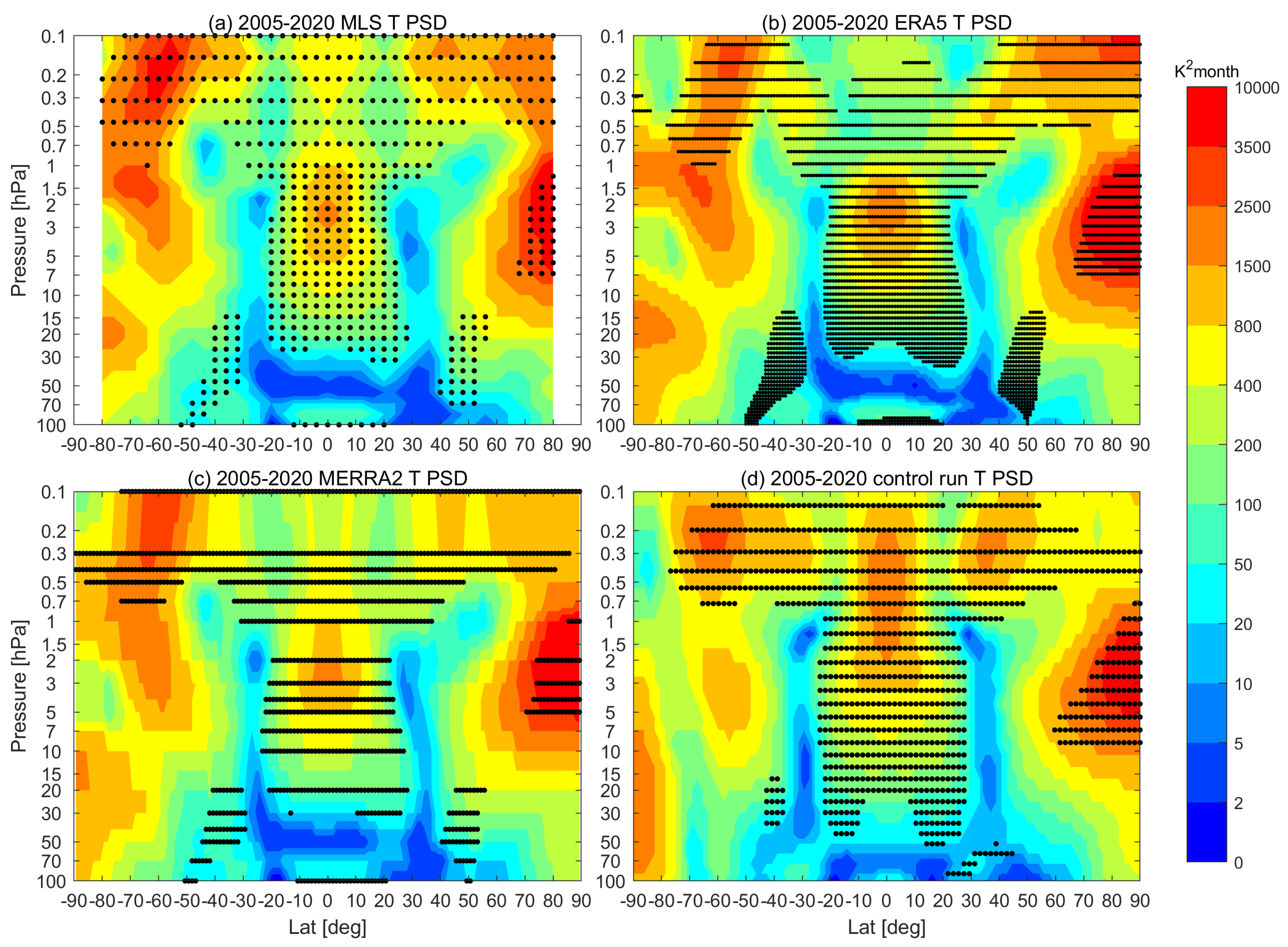
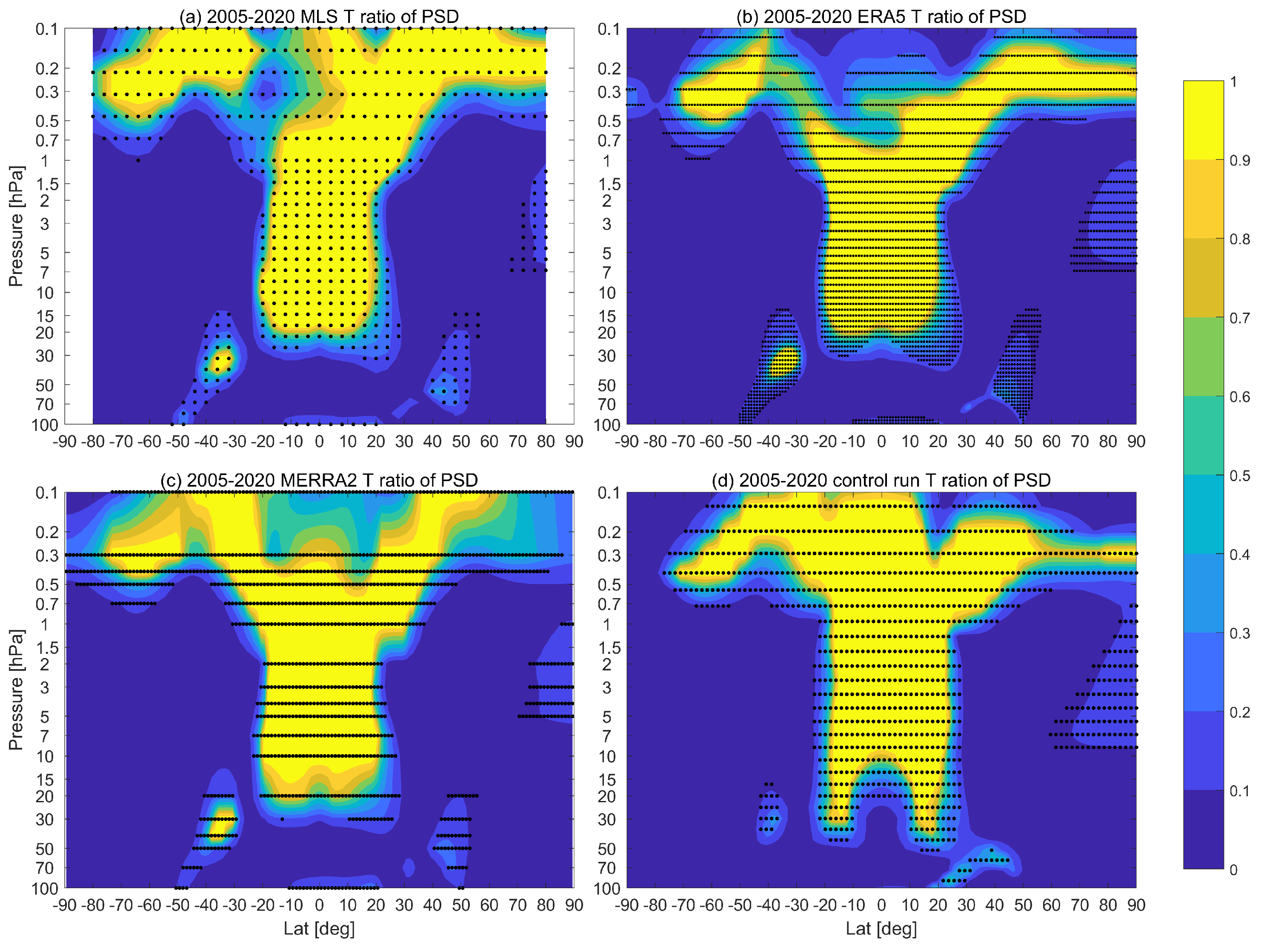

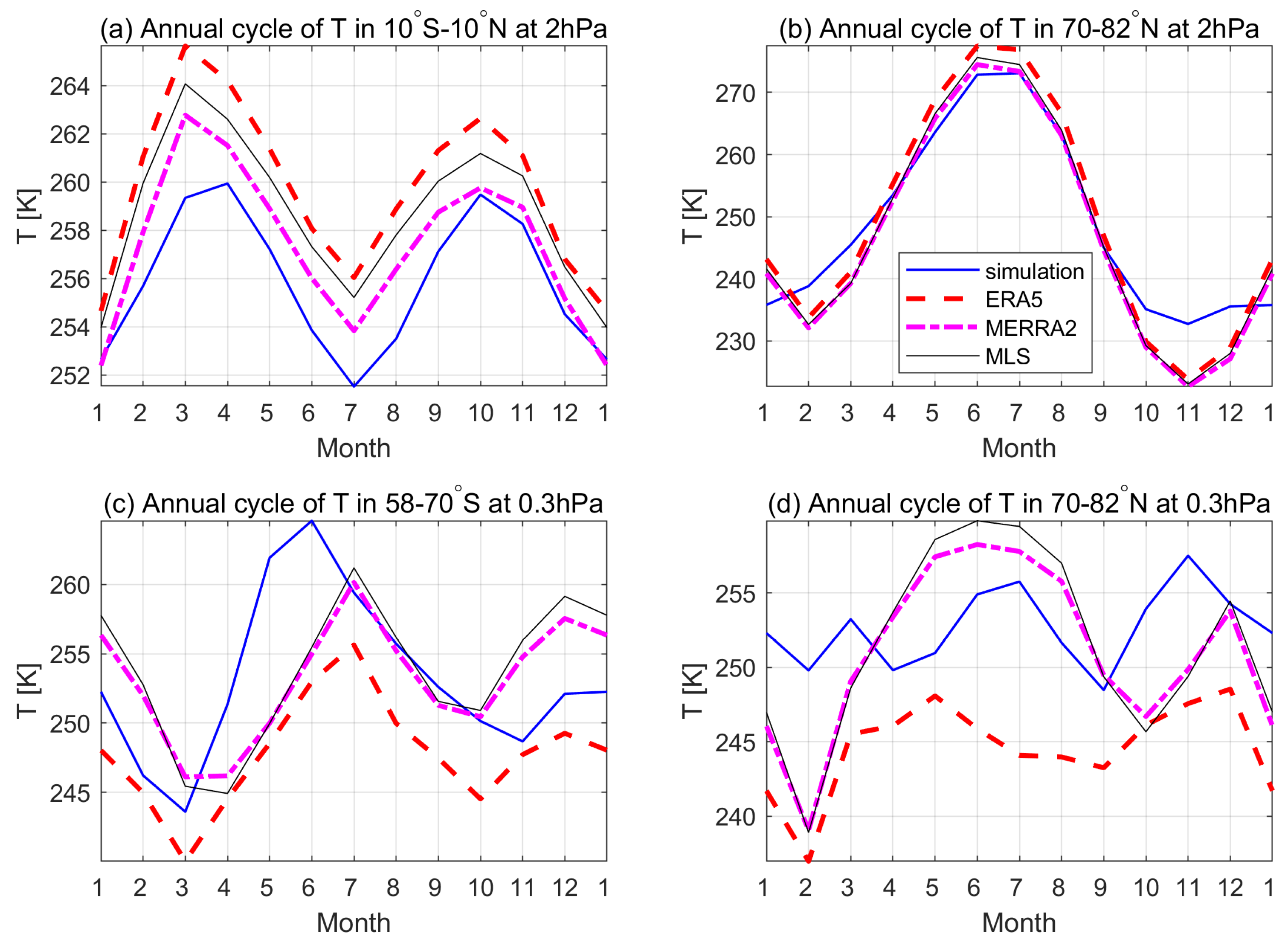
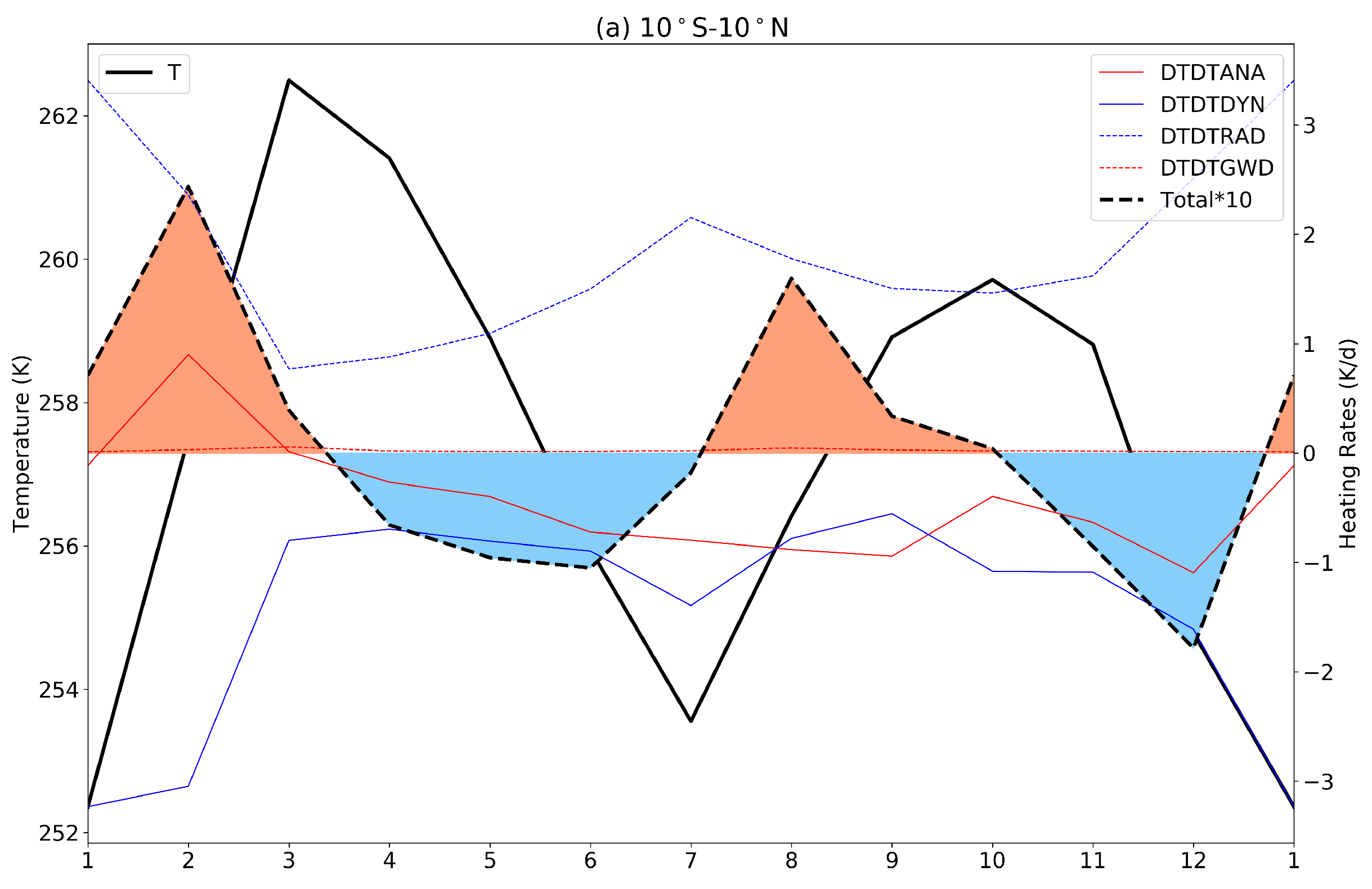

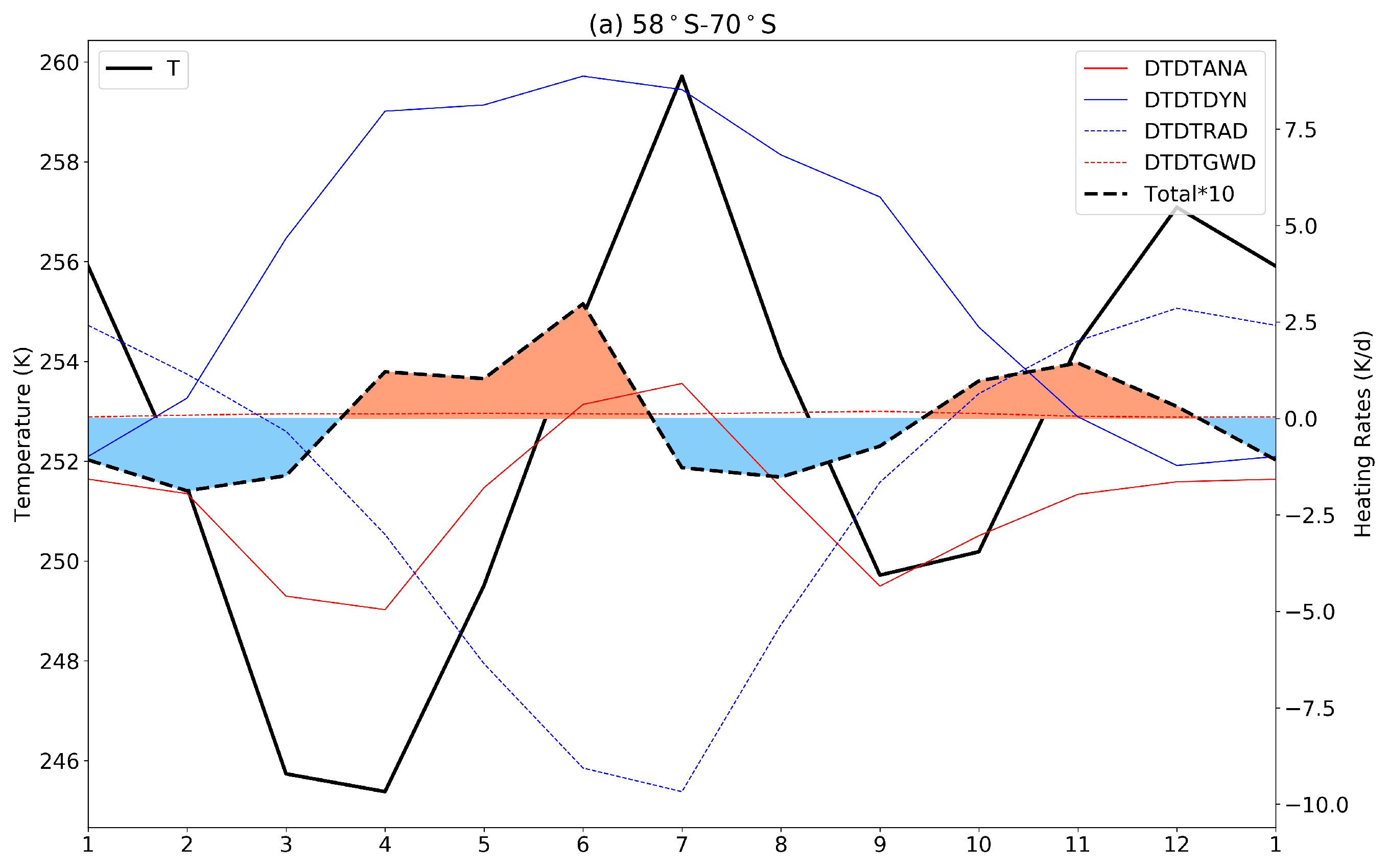
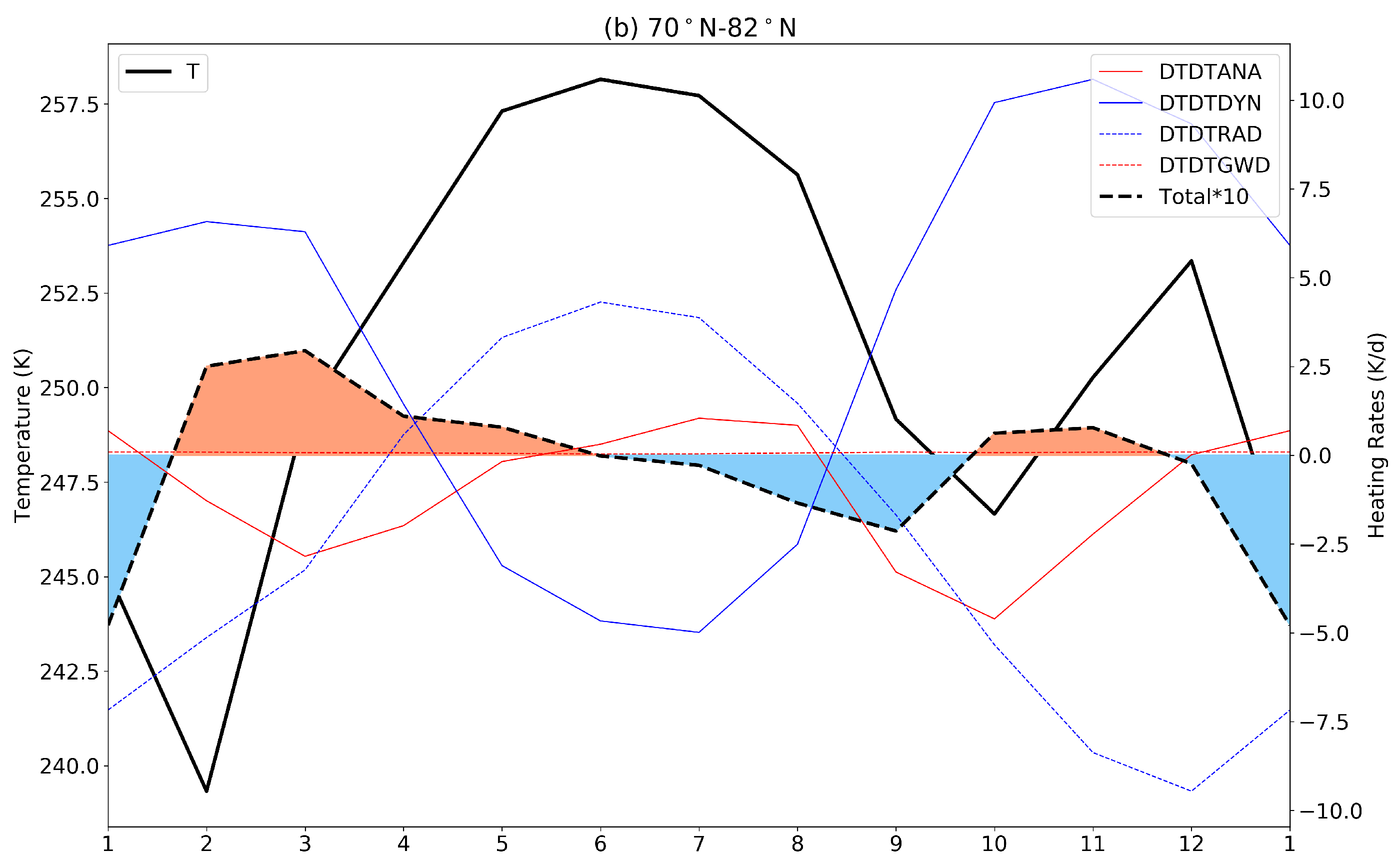
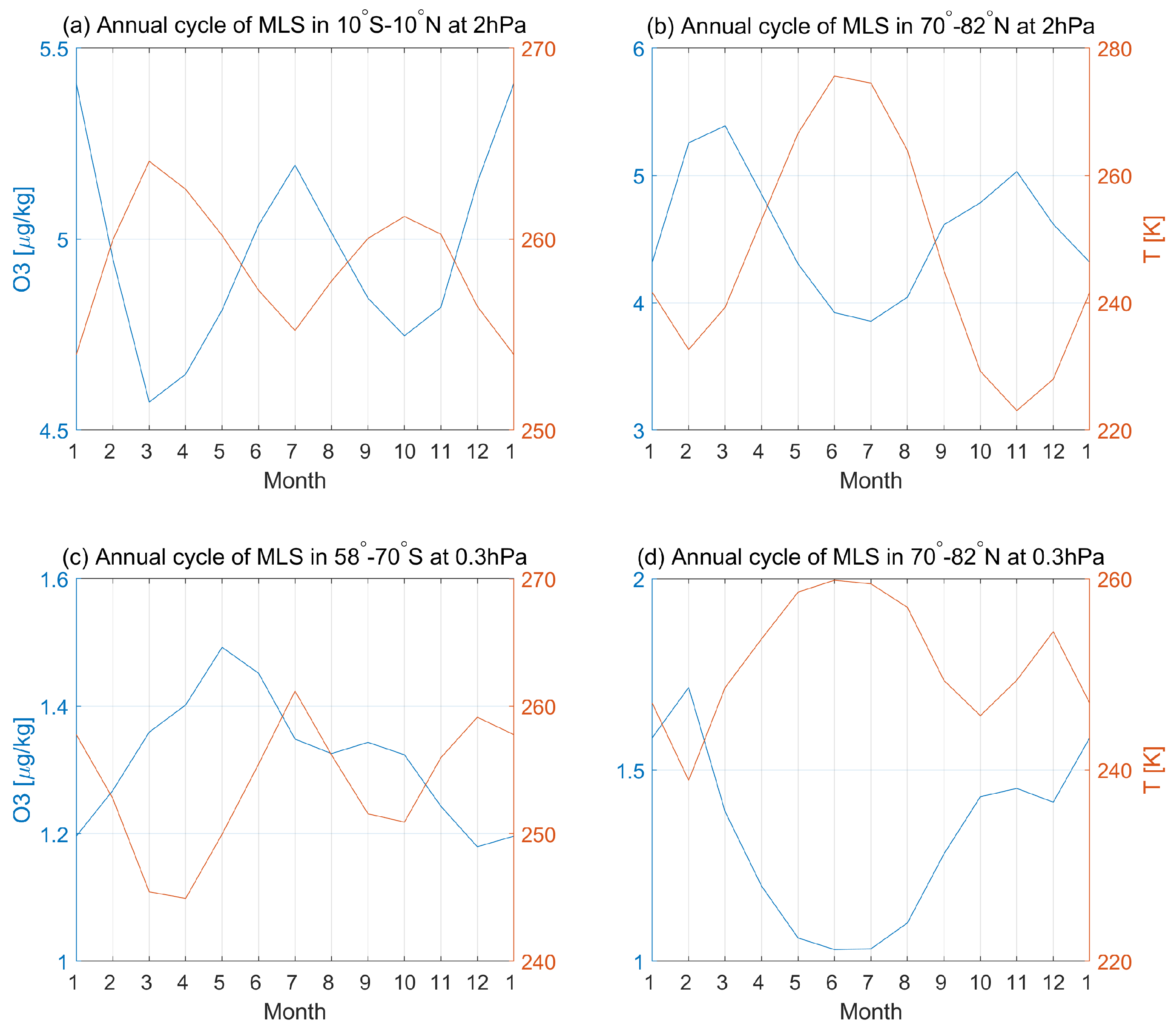

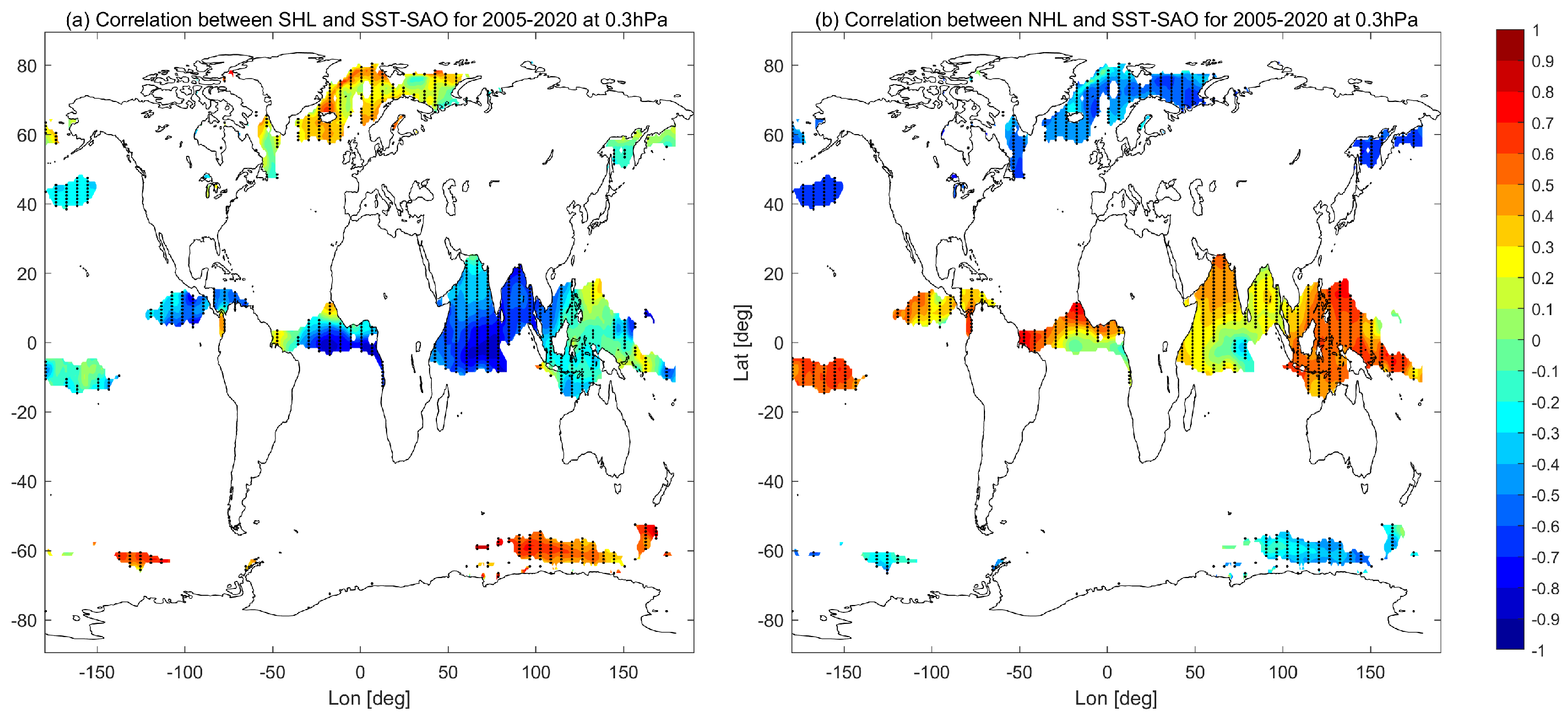

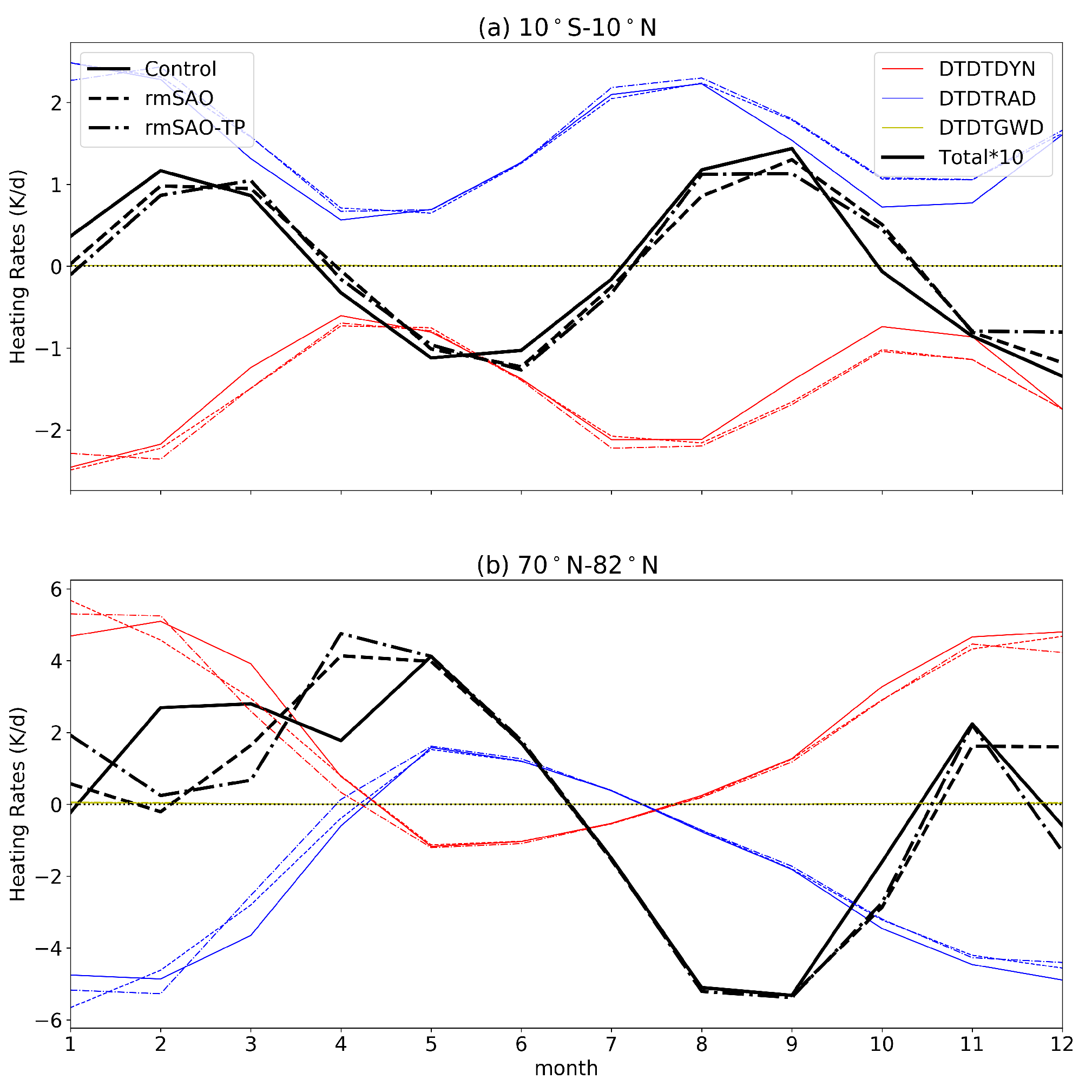
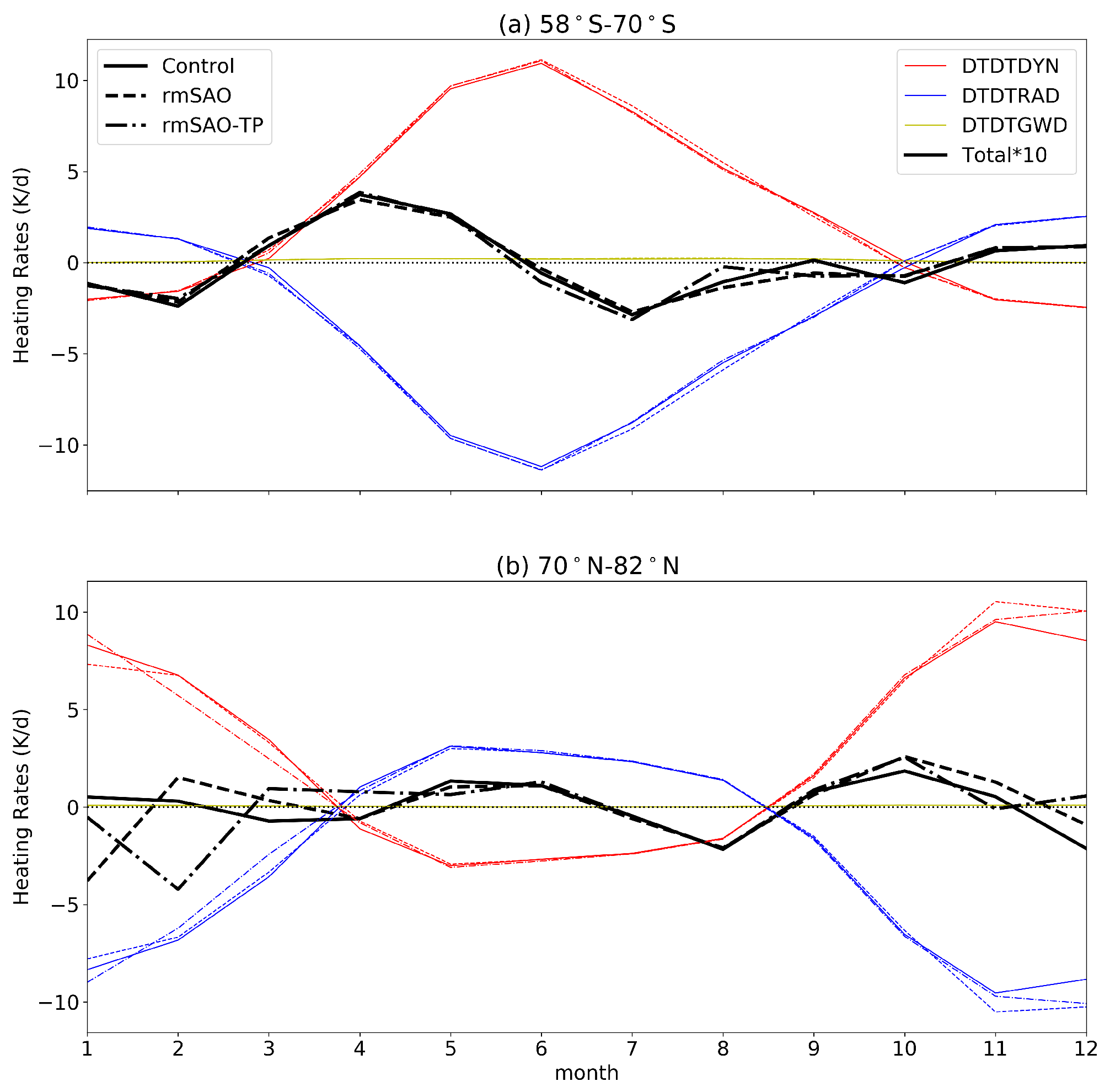
Disclaimer/Publisher’s Note: The statements, opinions and data contained in all publications are solely those of the individual author(s) and contributor(s) and not of MDPI and/or the editor(s). MDPI and/or the editor(s) disclaim responsibility for any injury to people or property resulting from any ideas, methods, instructions or products referred to in the content. |
© 2023 by the authors. Licensee MDPI, Basel, Switzerland. This article is an open access article distributed under the terms and conditions of the Creative Commons Attribution (CC BY) license (https://creativecommons.org/licenses/by/4.0/).
Share and Cite
Shangguan, M.; Wang, W. Analysis of Temperature Semi-Annual Oscillations (SAO) in the Middle Atmosphere. Remote Sens. 2023, 15, 857. https://doi.org/10.3390/rs15030857
Shangguan M, Wang W. Analysis of Temperature Semi-Annual Oscillations (SAO) in the Middle Atmosphere. Remote Sensing. 2023; 15(3):857. https://doi.org/10.3390/rs15030857
Chicago/Turabian StyleShangguan, Ming, and Wuke Wang. 2023. "Analysis of Temperature Semi-Annual Oscillations (SAO) in the Middle Atmosphere" Remote Sensing 15, no. 3: 857. https://doi.org/10.3390/rs15030857
APA StyleShangguan, M., & Wang, W. (2023). Analysis of Temperature Semi-Annual Oscillations (SAO) in the Middle Atmosphere. Remote Sensing, 15(3), 857. https://doi.org/10.3390/rs15030857





